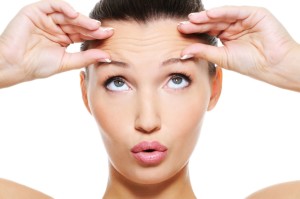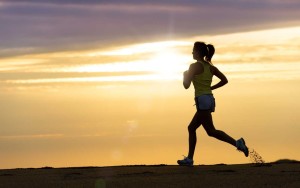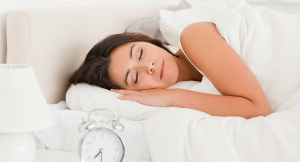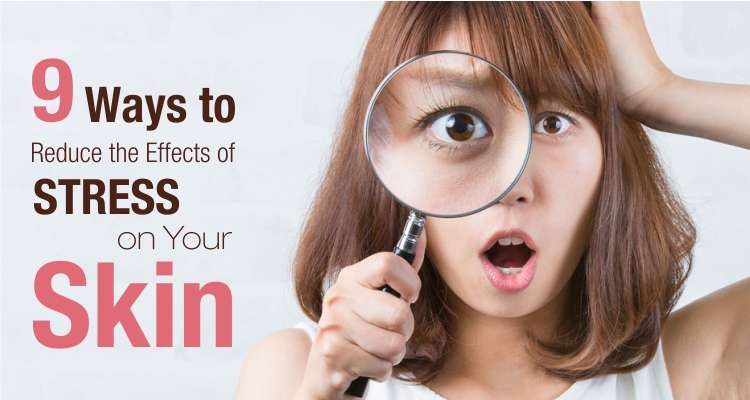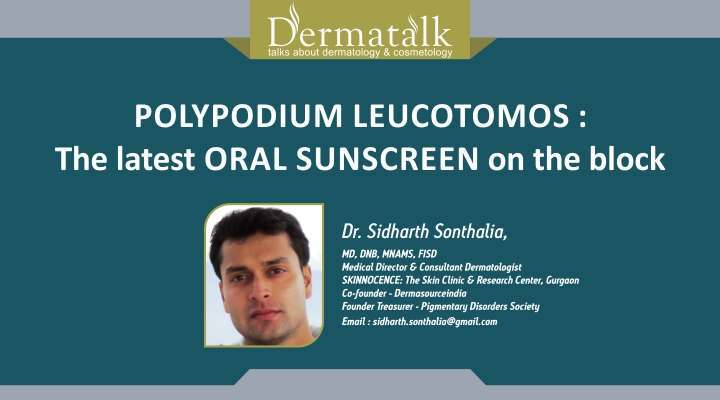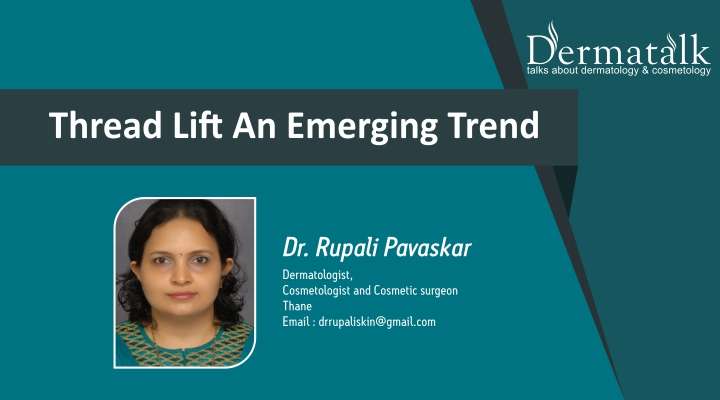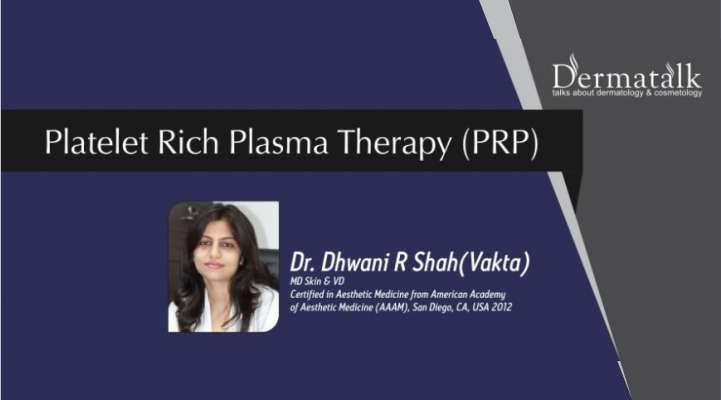The pathogenetic role of UV radiation in phototoxic reactions and photoallergic dermatoses such as polymorphous light eruption (PMLE) has now become axiomatic. While sun-induced acute sunburn,melanomas, and nonmelanoma skin cancers (NMSC) are the primary concerns of people with Fitzpatrick skin Types I–III, the darker ethnic population ought to have effective sun protection as well, primarily for the prevention and management of photoallergic dermatoses and hyperpigmentation. Although the skin of color (SOC) is at a relatively less risk of developing skin cancers, it is not totally immune from them. The incidence of both melanoma and NMSCs is approximately 5% in Hispanics, 4% in Asians, and 2% in blacks.[1] In people with SOC, both basal cell skin cancers and squamous cell carcinomas may arise, with the former being the most common form of skin cancer associated with SOC.[2] Of late, the pathogenetic role of UV radiation on accelerating premature graying of hair has also been recognized.[3] In essence, one needs effective sunscreens for sun protection on a daily basis. However, the acceptability and compliance with the use of topical sunscreens depend on various factors Although broad spectrum topical sunscreens constitute the most important component of sun protection, they have many limitations that culminate into noncompliance or sub-optimal use. Even in populations at high risk of UV-induced skin cancers, dherence with sunscreen application has been reported low despite the awareness of the benefits of sunscreen.[4]
Limitations of Topical Sunscreens
In order to achieve the labeled sun protection factor (SPF), a uniform application of 2 mg/cm2 sunscreen is recommended, for which at least one teaspoon (around 3 ml) of preparation should be applied on the face, neck, and nape. However, in reality, most patients apply much lesser amounts, resulting in sub-optimal application thickness, as reported in a recent study.[5] A sunscreen should ideally be applied at least 30 min prior to anticipated exposure. In practical experience, it is often not feasible for busy professionals. Moreover, reapplication every 2–3 h, after swimming, excessive sweating, etc., becomes a strong barrier to compliance. The cosmetic acceptability of the sunscreen is also important, especially for women. The opaque nature and “whitening effect” of physical sunscreens containing zinc oxide (ZnO) and/or titanium dioxide (TiO) are an inherent disadvantage which has now been minimized by the use of nanosized particles (NP) (size 1–100 nm). However, in recent years, there have been concerns about the possibility of NP penetrating the stratum corneum with resultant genotoxicity. Despite many studies establishing the safety of TiO and ZnO NP, skepticism about the possibility of genotoxicity by NP-grade TiO continues to simmer.[6]
Further on, photoallergic reactions are fairly common with topical sunscreens. The demands of having positive attributes in a including high SPF, easy spreadability, high substantivity, sweat and water resistance, nonoily feel, photostability, cosmetic acceptability, etc., have led to the development of complex sunscreen products with very long ingredient lists in terms of both active agents and excipients, increasing their allergenic potential.[7] Last but not least, a topical sunscreen will provide UV protection only over the areas where it is applied over, that is, it is devoid of “systemic sun protection.” Patients frequently need to use huge amounts of sunscreen during beach exposure to prevent tanning.
Advantages of “Systemic Sunscreens”
The above-mentioned reasons have led to the topical sunscreen often being used inadequately or improperly. An “ideal” oral sunscreen which would be as effective as a topical sunscreen say, with an SPF of 30 or more would have several advantages, with convenience and ease of use topping the list. Patients would find it much easier to pop-in a pill and rather than applying the topical sunscreen every 2–3 h. The performance of oral sunscreens would not be affected by external conditions, such as swimming, types of garment, or sweating. Most importantly, an effective oral sunscreen will provide protection to the entire body, including the trunk, lower limbs, as well as scalp, and hair. Until now, compounds with strong anti-oxidant potential including Vitamins C and E, polyphenols, carotenoids,
lycopene, flavonoids, proanthocyanidin, and other anti-oxidants have been prescribed to provide only ancillary sun protection over and above the topical sunscreens.[8] The latest in this league is a specific fern extract called Polypodium leucotomos (PL), which seems to be effective to a certain extent in providing photoprotection, when taken orally.
Polypodium leucotomos: The Latest Oral Sunscreen on the Block
PL or anapsos, a synonym, is a South American species of fern in the family Polypodiaceae. Extant research has shown that extracts of PL possess robust anti-oxidant, photoprotectant, antimutagenic, and immunoregulatory properties.[9] The extracts of PL applied topically or taken orally have been shown to be effective in several dermatoses in research conducted over the last four decades, such as psoriasis and vitiligo. Since then, a variety of other dermatoses including atopic dermatitis, and more importantly, photo-responsive dermatoses such as PMLE, solar urticaria, and melisma, have been reported to improve with intake of this fern’s extracts.[9] PL is a natural mixture of phytochemicals with powerful anti-oxidant and photoprotective properties, including acids such as ferulic, caffeic, vanillic,p-coumaric, 3,4- dihydroxybenzoic, 4-hydroxybenzoic, hydroxycinnamic, 4-hydroxycinnamoyl-quinic, and chlorogenic. The versatility of its use stems from its pleiotropic effects. The evidence favoring the UV protective effect of oral PL is growing. Its mechanisms of effect include:
1. Anti-oxidant activity: The anti-oxidant activity of PL results in the control of cutaneous responses to UV-induced erythema.[9] UV-induced erythema and skin damage are primarily a result of reactive oxygen species (ROS) produced at the cellular level. PL inhibits the generation of ROS at a molecular and cellular level to enhance endogenous anti-oxidant systems
2. Photo prevention: The photoprotective effect of PL stems from a concerted anti-oxidant, anti-angiogenetic, and extracellular matrix remodeling effects.[9,10] PL inhibits UV-mediated oxidative DNA mutations, prevents photodecomposition of both endogenous photoprotective molecules and DNA, and enhances DNA repair. Acting at a cellular level, PL acts at the cellular level, improving cell membrane integrity and elastin expression, resulting in prevention and repair of solar damage
3. Cancer prevention: PL has also been shown to increase epidermal p53 expression and accelerate the removal of UV-induced photoproducts, highlighting its anti-carcinogenic role.[11]
Modern studies involving animal models, in vivo human skin cell cultures and human volunteers have evaluated the efficacy of polymorphic light eruption (PLE) orally as a photoprotective agent and for use in several photo-aggravated dermatologic disorders, melisma, and vitiligo.
Evidence Favoring Photoprotective Properties of Polypodium leucotomos
After initial encouraging results from mice-based studies, Alonso-Lebrero et al. determined the effects of PL in the presence of UVA or UVB radiation on markers of solar elastosis, collagen reduction, and increased expression of matrix metalloproteinases (MMPs). Fibroblasts and keratinocytes, respectively, were irradiated by a single exposure to UVA or UVB radiation, and then incubated with or without PL. PL significantly improved membrane integrity, inhibited lipid peroxidation, increased elastin expression, and inhibited MMP-1 expression in both fibroblasts, and keratinocytes, in the presence of UVA as well as UVB.[10] In one of the pioneer studies conducted by González et al., 21 healthy volunteers were exposed to solar radiation with oral psoralens and immediate pigment darkening (IPD), minimal erythema dose (MED), minimal melanogenic dose, and minimal phototoxic dose (MPD) were evaluated, before and after topical or oral administration of PL. PL significantly increased UV dose required for IPD, MED as well as MPD, both after topical and oral administration.[12] In a randomized, double-blind, placebo-controlled human volunteer study conducted by Nestor et al., oral PL (240 mg.) was administered twice daily to 10 healthy adults, aged 18–65 years with Fitzpatrick skin Types I–IV for 60 days. The subjects in the treatment group showed a lesser likelihood of experiencing ≥1 episodes of sunburn, increased MED, and decreased UV-induced erythema intensity; all results being statistically significant. There were no changes in any safety assessment parameters.[9]
Efficacy of Polypodium leucotomos in Vitiligo: Enhancing Repigmentation,Decreasing Phototoxicity
Recent trials have confirmed that when phototherapy is delivered with PL, there is a definite enhancement of efficacy. A randomized, double-blind, placebo-controlled pilot study of patients with generalized vitiligo (n = 19) and healthy controls (n = 19), that compared the combined efficacy of psoralen plus ultraviolet A (PUVA) plus oral PL versus PUVA plus placebo, reported a significantly higher percentage of patients with > 50% skin repigmentation among patients who received PL.[13] In another randomized study with generalized vitiligo (n = 57), combination therapy with twice weekly narrow-band (NB)-UVB and once daily PL 480 mg resulted in 40% re-pigmentation, compared to 22%for NB-UVB phototherapy alone.[14] Middelkamp-Hup et al. conducted two separate studies to assess the efficacy of PL as an effective chemophotoprotector against PUVA-induced skin phototoxicity.[15,16] Healthy participants (n = 19) with skin phototypes II to III were exposed to UVA alone (n = 9) or with 0.6 mg/kg oral 8-methoxypsoralen (n = 10), without and after administration of 7.5 mg/kg of oral PL. Clinically, a significant decrease in erythema was found in PL-treated skin after 48–72 h. Histologically, PLE-treated skin revealed cellular changes that confirmed the chemoprotective effect of PLE against PUVA-induced skin phototoxicity.
Efficacy of Polypodium leucotomos in Melasma
The beneficial effects of PL in melasma need further elucidation. One recent study demonstrated the clinical efficacy of PL in melasma. Female subjects (n = 21; aged 18–50 years) with epidermal melasma (n = 21) were randomized to receive oral PL or placebo twice daily for 12 weeks, with additional application of a sunscreen (SPF-45) daily. At 12 weeks, patients who are treated with PL showed significantly decreased mean Melasma area and severity index (MASI) scores whereas the placebo group did not.[17] However, contrary findings were observed in another randomized, double-blinded, placebo-controlled trial conducted in 33 Hispanic women with moderate to severe facial melasma.[18] They were randomized to receive either 240 mg oral PL or placebo, 3 times daily for 12 weeks. All subjects were given a standard, broad spectrum, and topical sunscreen to use every morning. While both groups showed significant improvement in melanin index and MASI at week 12, the intergroup difference was statistically insignificant.
Safety
In nearly all studies mentioned above, no significant adverse effects were reported in the PL groups. In a status report on clinical efficacy and safety of PL based on data interpreted from 19 human and 6 basic science studies spanning over 40 years of research, they concluded that PL is well-tolerated at all doses administered (120–1080 mg/day) and associated with a negligible risk of side effects. While laboratory studies did not report any adverse effect; mild to moderate astrointestinal complaints and pruritus were reported only in 2% human cases (16/1016).[19] No significant drug interactions have been reported. However, data on long-term and safety in children, pregnant and lactating women are lacking. Notably,commercial capsules of PL are not free from gluten so should not be consumed by gluten-sensitive people.
Commercial Availability of Polypodium leucotomos
Globally, PL capsules are most commonly available under the category of “health supplement,” under various brand names. Specific brands are popular in different countries.The commercially available PL containing capsules typically contain 240 mg of the extract of PL; and often additionally contain Vitamins C and E and lycopene. As per the general recommendations of leading manufacturers of this compound:
1. The capsules should be consumed 30 min before sun exposure
2. On a day with regular sun exposure, 2 capsules should be taken per day (1 in the morning and 1 in the midday). On a day for intense sun exposure, 4 capsules should be taken (2 in the morning and 2 in the midday, that is, 3 h after first dose)
3. Recommended duration of therapy: The capsules should be taken “daily (indefinitely) to provide continuous adjuvant sun protection.”
Controversies about Polypodium leucotomos
The biggest dilemma about the practical utility of PL capsules as “oral sunscreen” stems from the following factors:
1. There are no published studies to date that directly compare oral PL supplements to topical sunscreens. Moreover, oral sunscreens cannot be labeled with an SPF. González, one of the pioneer researchers of PL, has suggested that this drug offers an SPF of about 3–5; insufficient (if used alone) for most people that need sunscreen[20]
2. Data about absorption of PL extracts and how much of the absorbed drug reaches the skin to provide photoprotection are not available
3. The dose and schedule have not been precisely specified for any indication. The doses used in trials for different indications have generally ranged from 240 mg to 480 mg/day. The basis of the manufacturer’s recommendations of the dosages (vide supra) are based upon these limited number of trials. The studies conducted in healthy volunteers suffered from one or more of the following flaws: Modest sample size, lack of control group in some studies, no rationale for the dose used, lack of blinding, lack of evaluation of long-term effects, and use of UVA sensitizers to enhance UVA damage which cannot be extrapolated to its usefulness in real life sun protection from regular or intermittent sun exposure
Conclusion
Although the idea of a well-tolerated, safe, oral supplement that protects against UVA and UVB without the need for topical products is an attractive one, we need more evidence to confirm the efficacy and safety of PL fulfilling these criteria. At present, the quality of evidence in favor of PL for any particular condition is not robust. The studies mentioned above, of course, cannot be ignored, and considering their positive outcomes, PL seems to be effective in reducing some of the severity of sunburn, and may provide some UV protection in photodermatoses and patients undergoing phototherapy. Its role in pigmentation reduction and anti-aging remains unclear. It is clear that PL cannot be an alternative, but only an adjuvant to topical sunscreens. Its current evidence-based clinical utility seems to lie in a mild adjuvant role to topical sunscreens, prevention of sunburns in fair-skinned people, and possibly in vitiligo to enhance repigmentation and reduce phototoxicity of UVA or UVB therapy.
Financial support and sponsorship
Nil.
Conflicts of interest
There are no conflicts of interest.
References
1. Gloster HM Jr, Neal K. Skin cancer in skin of color. J Am Acad Dermatol 2006;55:741-60.
2. Agbai ON, Buster K, Sanchez M, Hernandez C, Kundu RV, Chiu M, et al. Skin cancer and photoprotection in people of color: A review and recommendations for physicians and the public. J Am Acad Dermatol 2014;70:748-62.
3. Pandhi D, Khanna D. Premature graying of hair. Indian J Dermatol Venereol Leprol 2013;79:641-53.
4. Pissavini M, Doucet O, Diffey B. A novel proposal for labelling sunscreens based on compliance and performance. Int J Cosmet Sci 2013;35:510-4.
5. Novick R, Anderson G, Miller E, Allgeier D, Unice K. Factors that influence sunscreen application thickness and potential reservative exposure. Photodermatol Photoimmunol Photomed 2015;31:212-23.
6. Nohynek GJ, Dufour EK. Nano-sized cosmetic formulations or solid nanoparticles in sunscreens: A risk to human health? Arch Toxicol 2012;86:1063-75.
7. Saraswat A. Contact allergy to topical corticosteroids and sunscreens. Indian J Dermatol Venereol Leprol 2012;78:552-9.
8. Skotarczak K, Osmola-Mankowska A, Lodyga M, Polanska A, Mazur M, Adamski Z. Photoprotection: Facts and controversies. Eur Rev Med Pharmacol Sci 2015;19:98-112.
9. Nestor MS, Berman B, Swenson N. Safety and efficacy of oral Polypodium leucotomos extract in healthy adult subjects. J Clin Aesthet Dermatol 2015;8:19-23.
10. Alonso-Lebrero JL, Domínguez-Jiménez C, Tejedor R, Brieva A, Pivel JP. Photoprotective properties of a hydrophilic extract of the fern Polypodium leucotomos on human skin cells.J Photochem Photobiol B 2003;70:31-7.
11. Rodríguez-Yanes E, Cuevas J, González S, Mallol J. Oral administration of Polypodium leucotomos delays skin tumor development and increases epidermal p53 expression and the anti-oxidant status of UV-irradiated hairless mice. Exp Dermatol 2014;23:526-8.
12. González S, Pathak MA, Cuevas J, Villarrubia VG, Fitzpatrick TB. Topical or oral administration with an extract of Polypodium leucotomos prevents acute sunburn and psoralen-induced phototoxic reactions as well as depletion of Langerhans cells in human skin. Photodermatol Photoimmunol Photomed 1997;13:50-60.
13. Reyes E, Jaén P, de las Heras E, Carrión F, Alvarez-Mon M, de Eusebio E, et al. Systemic immunomodulatory effects of Polypodium leucotomos as an adjuvant to PUVA therapy in generalized vitiligo: A pilot study. J Dermatol Sci 2006;41:213-6. 25
14. Middelkamp-Hup MA, Bos JD, Rius-Diaz F, Gonzalez S, Westerhof W. Treatment of vitiligo vulgaris with narrow-band UVB and oral Polypodium leucotomos extract: A randomized double-blind placebo-controlled study. J Eur Acad Dermatol Venereol 2007;21:942-50.
15. Middelkamp-Hup MA, Pathak MA, Parrado C, Garcia-Caballero T, Rius-Díaz F, Fitzpatrick TB, et al. Orally administered Polypodium leucotomos extract decreases psoralen-UVA-induced phototoxicity, pigmentation, and damage of human skin. J Am Acad Dermatol 2004;50:41-9.
16. Middelkamp-Hup MA, Pathak MA, Parrado C, Goukassian D, Rius-Díaz F, Mihm MC, et al. Oral Polypodium leucotomos extract decreases ultraviolet-induced damage of human skin.J Am Acad Dermatol 2004;51:910-8.
17. Martin LK, Caperton C, Woolery-lloyd H. A Randomized Double-Blind Placebo Controlled Study Evaluating the Effectiveness and Tolerability of Oral Polypodium leucotomos in Patients with Melasma. Presented at: American Academyof Dermatology Annual Meeting. San Diego, California;March 16-20, 2012. Available from: https://www.clinicaltrials.gov/ct2/show/NCT01162850. [Last accessed on 2015 Mar 26].
18. Ahmed AM, Lopez I, Perese F, Vasquez R, Hynan LS, Chong B, et al. A randomized, double-blinded, placebo-controlled trial of oral Polypodium leucotomos extract as an adjunct to sunscreen in the treatment of melasma. JAMA Dermatol 2013;149:981-3.
19. Winkelmann RR, Del Rosso J, Rigel DS. Polypodium leucotomos extract: A status report on clinical efficacy and safety. J Drugs Dermatol 2015;14:254-61.
20. Woolston C. Does heliocare combat the sun’s rays? Los Angeles Times; June 1, 2009. Available from: http://www.latimes.com/health/la-he-skeptic1-2009jun01-story.html. [Last accessed on 2015 Apr 17].

